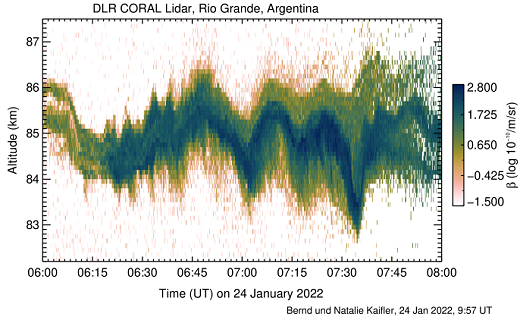Jan. 25, 2022: On Jan 24th, skies above Argentina suddenly filled with noctilucent clouds (NLCs). A video camera in Rio Gallegos (Patagonia) captured the outburst:
“What a surprise!” says Gerd Baumgarten of Germany’s Leibniz Institute of Atmospheric Physics, who operates this remote camera to monitor southern skies for unusual events. “We haven’t seen NLCs all year. Now, suddenly, they are very bright.”
NLCs are Earth’s highest clouds. They form when wisps of water vapor rise up from the poles to the edge of space. Water crystallizing around specks of meteor dust create the electric-blue structures. NLCs are, literally, frosted meteor smoke.
Normally at this time of year, NLCs are confined inside the Antarctic Circle. So it is a surprise to see them bursting out to mid-southern latitudes; Rio Gallegos is at 51.6oS.
To confirm that these are truly NLCs, Natalie Kaifler of the German Aerospace Center (DLR) pinged the clouds using a laser radar (lidar) in Rio Grande. The echos returned from 85 km above Earth’s surface:

This is exactly where NLCs typically form. Reality confirmed.
Where did these clouds come from? Maybe Tonga. The eruption of the Hunga Tonga–Hunga Haʻapai volcano on Jan. 15th hurled a plume of ash, sulfur dioxide and (this is the important part) water vapor more than 55 km high. Baumgarten and others are investigating the possibility that water from the volcano has reached the mesosphere, creating an outburst of noctilucent clouds. Stay tuned for more information.
Reblogged this on Tallbloke's Talkshop and commented:
Possible volcanic origin of these NLCs?
LikeLike